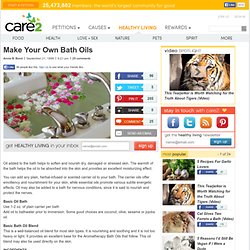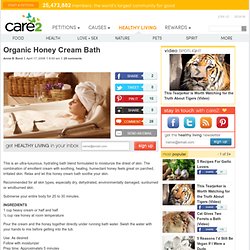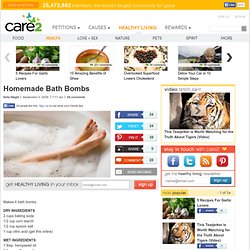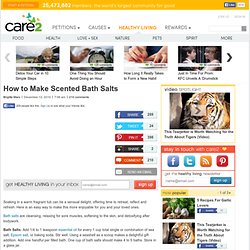

Detox Bath. I’d like to start making myself detoxifying baths.

How do I do this? Baths are wonderfully healing. Hot water draws toxins out of the body to the skin’s surface, and while the water cools it pulls toxins from the skin, according to Naturopath Dr. Hazel Parcells. Homemade Detox Baths. Baths are wonderfully healing, and it is easy to make your own homemade, detox baths.

Hot water draws toxins out of the body to the skin’s surface, and while the water cools it pulls toxins from the skin, according to Naturopath Dr. Hazel Parcells. Epsom salts augment this detoxification by causing you to sweat. Other salts—all highly alkaline and cleansing—used in baths include sea salt, baking soda, clay, and Dead Sea salts. Basic Salt Soak Bath Formula Minerals and salts make the bath water feel silky and leave your skin cleansed and soft. 1 cup sea salts 2 cups baking soda 1 cup Epsom salts 1 to 2 tablespoons glycerin per bath Combine the sea salts, baking soda, and Epsom salts in a bowl.
Preparation time: 2 to 3 minutes Shelf life: Indefinite Storage: Glass jar with a screw top Caution: Do not take hot baths and salt baths (including Epsom salt baths) if you have heart trouble, high blood pressure, or are diabetic. Making Your Own Herbal Hair Shampoo. In 1990 I decided not to use the commercially made shampoos after reading Aubrey Hampton’s book, “Natural Organic Hair and Skin Care.”

In this book Aubrey tells you how to read the label on any product that you put on your skin or hair. Manufacturers are constantly using toxic chemicals in their skin and hair products and disregard their toxic effects on your body. This is easily seen in the list of chemicals that they use. Here are a few of these chemicals found in many product labels: 1 propylene glycol or glycol– a petrochemical used because it is cheap 2 cetearyl alcohol – emulsifier that can be synthetic or natural 3 methylparaben or propylparaben – typical synthetic preservatives 4 distearate – this is polyethylene glycol or polypropylene glycol which are petrochemicals 5 isopropyl alcohol – used as a cheap solvent to carry synthetic oils. Here is a natural shampoo that you can make. First collect the following items: Mix the herbs in a mason jar, which has a lid.
Make Your Own Bath Oils. Oil added to the bath helps to soften and nourish dry, damaged or stressed skin.

The warmth of the bath helps the oil to be absorbed into the skin and provides an excellent moisturizing effect. You can add any plain, herbal-infused or scented carrier oil to your bath. The carrier oils offer emolliency and nourishment for your skin, while essential oils promote various subtle energetic effects. Organic Honey Cream Bath. This is an ultra-luxurious, hydrating bath blend formulated to moisturize the driest of skin.

The combination of emollient cream with soothing, healing, humectant honey feels great on parched, irritated skin. Relax and let this honey cream bath soothe your skin. Recommended for all skin types, especially dry, dehydrated, environmentally damaged, sunburned or windburned skin. Submerse your entire body for 20 to 30 minutes. INGREDIENTS 1 cup heavy cream or half and half ½ cup raw honey at room temperature Pour the cream and the honey together directly under running bath water.
Use: As desired Follow with moisturizer Prep time: Approximately 5 minutes Do not store; mix as needed Yield: 1 treatment Adapted from Organic Body Care Recipes by Stephanie Tourles (Storey Publishing, 2007). Homemade Bath Bombs. Makes 4 bath bombs DRY INGREDIENTS 2 cups baking soda 1/2 cup corn starch 1/2 cup epsom salt 1 cup citric acid (get this online) WET INGREDIENTS 1 tbsp. hempseed oil 1 tbsp sunflower oil 1 tbsp coconut oil 1 1/2 tbsp water 15 drops essential oil for fragrance (you can get all of these ingredients online) 1.

Whisk all of the dry ingredients together in a bowl. Mix this very well. 2. Note: You can substitute cocoa butter or shea butter for the hempseed or sunflower, but make sure that you’re using oils that haven’t had anything added to them. For more information or to subscribe at the introductory price of $10 a year, go to positivelygreen.com. How to Make Scented Bath Salts. Soaking in a warm fragrant tub can be a sensual delight, offering time to retreat, reflect and refresh.

Here is an easy way to make this more enjoyable for you and your loved ones. Bath salts are cleansing, relaxing for sore muscles, softening to the skin, and detoxifying after bodywork. Best Bath for Your Skin Type (Page 2) By Lindsey Galloway, Natural Solutions magazine Europeans have long known the true origin of the word spa: Aanitas per agua, or “health through water.”

Before facials and massages became synonymous with spas, bathing was the premier avenue to personal wellness and whole-body detoxification. The citizens of ancient Rome considered a daily bath their civic duty to maintain public health. Since the late 1700s and through to the present day, German physicians have prescribed to stressed patients a kur (cure or treatment) consisting of one bath a day for 10 to 20 days.
And since the end of the 19th century, the French have indulged in thalassotherapy baths, which harness the anti-aging powers of ocean water and seaweed. Health Benefits of Epsom Salt Baths In America, we’ve just begun to catch on to the skin-saving benefits of relaxing baths, says Andria Roth, lead aesthetician at Oasis Spa in Woodinville, Washington.